|
2C Update #134
-
Vava'u,
Tonga Part 3 (September 15 - November 29, 2005)
(Photographs...by the 2Cs)
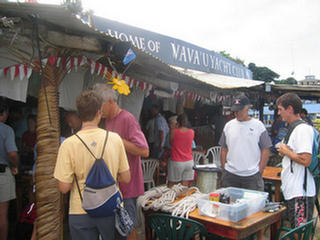
Weather,
boat projects and my writing endeavors kept us in Neiafu
a full week. It was not all work and no play.
There was plenty of socialization with other cruisers,
many restaurants sampled, more than a few beers raised,
and lots of DVDs swapped. Don made several
watermaker consultations, we sold of a bunch of stuff at
a Saturday morning swap meet, and we kept the water
tanks filled just by opening the deck fills.
By the end of the
week I was done with my two articles, the sun was
shining again, and it was time to get back to the
serious business of being boat bums.
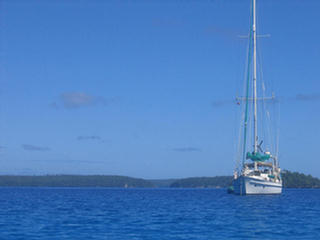 Our first stop was
Port Maurelle (#7). This is one of those lovely
anchorages that could be almost anywhere. A deep
U-shape with a sand beach at its head and surrounded by
arms of thick green, it is a very peaceful place to swim
or kayak, of which I did both. The air seems a full five
degrees cooler than town, and though one of the closest
anchorages to Neiafu, there were only a handful of boats
there. The next morning we sailed slowly south
under genoa alone to a small island called Mounu where
we picked up a mooring about lunchtime. Mounu, the
smallest of four islands dotting Vava’u’s east-west reef
belt, is the site of a family-run, upper-end fale
beach resort. They also run Whale Watch Vava’u, a
whale-watching boat that no fewer than four of our local
friends had recommended as the best. After lunch,
we went ashore and walked the shaded paths and the
glittering beach, and while there, we signed up to go
whale watching the next day. Our first stop was
Port Maurelle (#7). This is one of those lovely
anchorages that could be almost anywhere. A deep
U-shape with a sand beach at its head and surrounded by
arms of thick green, it is a very peaceful place to swim
or kayak, of which I did both. The air seems a full five
degrees cooler than town, and though one of the closest
anchorages to Neiafu, there were only a handful of boats
there. The next morning we sailed slowly south
under genoa alone to a small island called Mounu where
we picked up a mooring about lunchtime. Mounu, the
smallest of four islands dotting Vava’u’s east-west reef
belt, is the site of a family-run, upper-end fale
beach resort. They also run Whale Watch Vava’u, a
whale-watching boat that no fewer than four of our local
friends had recommended as the best. After lunch,
we went ashore and walked the shaded paths and the
glittering beach, and while there, we signed up to go
whale watching the next day.
Whale watching is
big business in Vava’u. During the austral winter
from June to October, humpback whales migrate here from
Antarctica to breed and calve in Tonga’s warm and
protected waters. We used to have humpback whales
similarly visit the Virgins, but it was never like
Tonga. In all my years in the Virgins I had three
or four sightings. Here we saw two on our first
day, and cruisers who were here in August and September
show photographs of whales swimming among the anchored
yachts in busy anchorages like Port Maurelle!
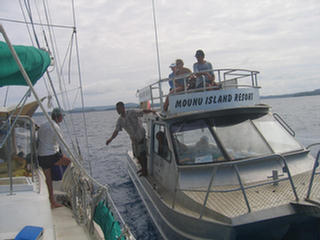 Tonga is the last
place in the world where sightseers can legally swim
with humpbacks. After my all-too-fleeting
encounter with the mother and calf in Niuatoputapu, I
wanted more, and so we found ourselves boarding Whale
Watch Vava’u’s power cat early the morning of October 5th.
I mention the date because already we were very late in
the season. Most of the whales had started south.
The day before all the operators had come up a bust,
including Whale Watch Vava’u. Some of the folks on
the boat with us were getting a second chance. Tonga is the last
place in the world where sightseers can legally swim
with humpbacks. After my all-too-fleeting
encounter with the mother and calf in Niuatoputapu, I
wanted more, and so we found ourselves boarding Whale
Watch Vava’u’s power cat early the morning of October 5th.
I mention the date because already we were very late in
the season. Most of the whales had started south.
The day before all the operators had come up a bust,
including Whale Watch Vava’u. Some of the folks on
the boat with us were getting a second chance.
We were luckier.
We weren’t away from of Mounu for more than ten minutes
before Lole, our guide, sighted a whale off the reefs of
Kapa Island. The boat approached to within a
hundred yards and then paced the mother and calf awhile
to see what she was about. Earlier in the season,
when the calves are young, a mother whale will often
hang motionless at the surface while her baby feeds or
plays around her. These are the “swim
opportunities” the whale-watch operators dream of
because the whales incredibly seem not to care who else
is in the water with them. Our whale had a
different agenda. During the course of the
morning, she swam a huge loop, surfacing and diving but
never stopping, perhaps conditioning her youngster for
the long swim south. Our best hope was for a “fly
by.” Don and I were in the first group of four to
be put in the water. We donned our skin gear,
stood ready on the aft platform as the boat maneuvered
itself “downwind” of her path, and slipped into the
water as one group behind our Tongan guide.
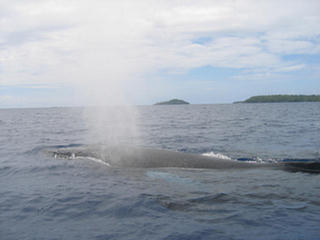 |
|
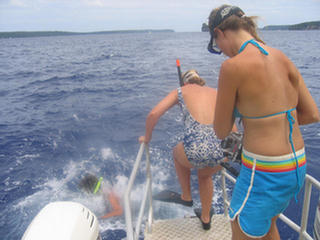 |
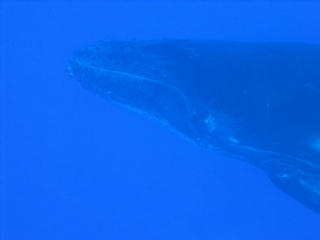
Holy smokes, here
she came, swimming slowly and steadily, her calf
slipping around and alongside her, to all appearances
untroubled by the clump of five swimmers hanging in the
water. The mother was some 60 feet long, and the
calf 20 feet. We could clearly see the
characteristic “upside-down”-looking jaw, the nodules
that blemish their faces, the eye…. A fleet of
remoras accompanied them. They passed no
more than fifteen feet away and without breaking stride,
dipped to swim under the boat. It was over pretty
quickly, but it was waaaaaay cool. The next two
swim groups didn’t get half as close. We followed
the whale most of the morning sometimes coming close for
short periods, then backing off to give them breathing
room for much of the time. We saw the whole
repertoire of whale stuff: spouts, dives, fluke flips,
barrel rolls and fin waves. The baby “spyhopped”
once, where the whale rises up vertically in the water
to take a look around. Once the mother came
up right alongside the boat and blasted us all with
water, and later in the afternoon she came up alongside
again and …how can I describe it…vocalized! After we
moved away to give her space, she breached with a huge
splash behind our backs! A little while later each
of the groups got a second “fly-by.” This time the
pair swam right at us, dipping at the last moment to
swim under us the way they had the boat on the first
encounter.
About this time it
became evident that we had the only whale of the day as
all the other whale watch boats fell into line.
The Vava’u operators have a creed that when there is
more than one boat “on” a whale, they will take turns.
Obviously, since we’d had this whale to ourselves most
of the day, it was our turn to peel off. Instead
Lole drove the boat fast up along Vava’u’s dramatic
north side hoping to pick up another pair.
Although we didn’t find any more, we sure had a great
sightseeing run where we would not likely ever come with
the sailboat.
In writing this
Update I have been reviewing what little information on
humpbacks I have available on board. Some of the
articles in Encarta suggest that whale-watch operators
stalking the whales may constitute almost as much
harassment of whale populations as did the hunters of
old. I don’t know. It’s an uncomfortable
thought that something I enjoyed so much could be bad.
As in anything like this, I think it is all how it is
managed. It seemed to us that Lole gave the mother
and calf plenty of room most of the day, only
approaching for short periods at a time, and that the
way our fly-by swim encounters were managed she could
have avoided us easily had she felt interfered with.
I asked Lole if they ever had trouble with a whale
getting irritated or aggressive, and he told me they
hadn’t, only occasionally with calves getting a bit
“frisky”. Even here there is plenty of debate
about whale watching, only here it is usually between
the tour operators who profess a code of conduct (but
perhaps are as motivated by protecting their business)
and the cruisers who jump in their dinghies and rush up
to whales who stumble into crowded anchorages.
Self restraint is a hard thing to master, but I would
hope cruisers who live so close to the ocean could
manage to behave responsibly, because, ecologically
sound or not, our swim encounters with the humpbacks in
Tonga rank as one of the most special experiences of our
entire voyage, and frankly I hope it will happen again
somewhere.
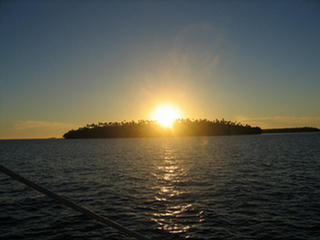 The very next day,
under sail on our way to Hunga, the farthest west of
Vava’u’s main group of islands, we saw four more whales
in maybe ten minutes. The first was a huge
solitary whale, perhaps a male, who gave a
picture-perfect flip of his tail as we glided near.
The next sighting was a mother and calf spouting
shoreward of us along the outer reef of the Blue Lagoon
anchorage, and the last was another solitary whale whose
course intersected ours and who obligingly ducked under
our bow. All four of these close sightings
happened merely as we were underway from one place to
another -- no seeking, no tracking involved -- so it is
quite possible to see Tonga’s whales without going with
a tour operator. However, these four were our last
sightings of the season. The very next day,
under sail on our way to Hunga, the farthest west of
Vava’u’s main group of islands, we saw four more whales
in maybe ten minutes. The first was a huge
solitary whale, perhaps a male, who gave a
picture-perfect flip of his tail as we glided near.
The next sighting was a mother and calf spouting
shoreward of us along the outer reef of the Blue Lagoon
anchorage, and the last was another solitary whale whose
course intersected ours and who obligingly ducked under
our bow. All four of these close sightings
happened merely as we were underway from one place to
another -- no seeking, no tracking involved -- so it is
quite possible to see Tonga’s whales without going with
a tour operator. However, these four were our last
sightings of the season.
|